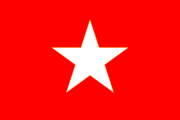Ganamukti Parishad
|
|
Muktiparishaderitikhatha.jpg
Gmptyfadcelectionposter2005.JPG
Tripura Rajaer Upajati Ganamukti Parishad (Tripura State Tribal Peoples Liberation Council)
In 1948 the Mukti Parishad (Liberation Council, later renamed Ganamukti Parishad) was formed as a struggle front against the despotic rule of the monarchic leadership of Tripura. The predecessors of the Mukti Parishad were the Janamangal Samiti (People’s Welfare Association), the Tripura Rajya Prajamandal (Tripura State Popular Assembly) and especially the Janasiksha Samiti (People’s Educational Association). All these organizations had a some influence from the local cell of the Communist Party of India. Also the Mukti Parishad was closely associated with the Communist Party, even though there were only two card-holding communists within its ranks at the time of the foundation of movement.
As Tripura was put under military rule in March 1949, the leadership of the Mukti Parishad went underground to escape arrests. In the tribal belts of the state armed resistance was organized by the GMP. Inspired by the advances of the Chinese PLA, the Mukti Parishad set up the Shanti Sena (Peace Army), which routed out the troops of the administration from the tribal belt. In the ‘liberated areas’ people’s government was in command, with the Village Committees of GMP managing the everyday affairs. The tribals didn’t have to pay any taxes to the state, nor would they turn to the courts of the state to express their queries. At the same time, a cultural revolution took place within the tribal society as abolition of child marriages, forced labour, excessive alcohol consumtion, oppression of women, etc. were outlawed by the GMP.
Armed resistance lasted until 1951. Then the strategies changed as a result of the changes in the political climate of the state. The Communist Party had begun to operate over-ground. In the end of 1949 the leaders of GMP had joined CPI. Now the struggle of the GMP was to be taken overground, in cooperation with CPI. In the first parliamentary elections of India in 1952 both seats of the Lok Sabha (2nd chamber of the Indian parliament) were won by the CPI. Both of the elected MPs, Biren Dutta and Dasarth Deb, were stalwarths of the GMP. Deb, the president of GMP, was at the time of election still considered as a guerrilla leader on the run by the police. The cases against him were not dropped until he was pardoned by the Prime Minister Jawaharlal Nehru himself after having reached the parliament premises incognito for his first session.
It should be mentioned that although the bulk of the leadership as well as the common members of the GMP were tribals, the GMP was not an exculsively tribal organization at this time (Biren Dutta, for example was a Bengali). After the end of the armed struggle, an intense debate surged within the CPI concerning the future role of the GMP. Some considered that the GMP, whose membership was overwhelmingly agrarian, should be integrated into the peasant mass organization of the party, AIKS, and that tribal and Bengali peasants should fight together since their class interests were the same. Other, such as Deb, considered that the tribals were not merely peasants but also constituted a separate sub-national entity and that the GMP should be a tribal organization articulating the sub-nationalist consiousness of the tribal community.
In the beginning of the 1960’s CPI suffered a severe internal division. The party was split into two camps on issues such as the relationship to the Congress party and the Sino-Soviet polemic. In 1964 the split was a fact, as two separate party congresses were held, one by CPI and the other by Communist Party of India (Marxist). The split also came to divide the Tripura unit of the CPI, with the CPI(M) soon having outmanovered the CPI in Tripura. Initially both factions agreed that the GMP ought to stay intact and that it would be spared from the split for the sake of unity of the mass organization movement, but soon competition over control over the organization started. At the GMP conference of 1967 the split had also reached the GMP, ending in the victory for the CPI(M) and it’s leader within the GMP, Deb, who were able to gather the support of the broad majority of the organization. At the same conference the GMP was re-christened as the Upajati (i.e. Tribal) Ganamukti Parishad. Subsequently, non-tribals were no longer able to obtain GMP membership. Thus Deb’s thesis that tribals constituted as separate subnationalist entity and needed a mass organization of their own had been implemented in the organizational practice.
Today the GMP is affiliated with the All India Kisan Sabha, the peasant mass-organization of the CPI(M). GMP does, however, maintain it’s own organizational character as an entirely tribal organization. Similarly, as the GMP is an affiliate to the AIKS, the Tribal Youth Federation is affiliated to the Democratic Youth Federation of India and the Tribal Students’ Union is affiliated to the Students’ Federation of India. However at the same time as these organizations belong to different all India structures, they are organizationally interlinked. The general secretary and president of TYF are by tradition elected as members of the secretariat of the GMP. The GMP, TYF and TSU use other flags, symbols and publications than their all India bodies. The leadership of these three organizations are referred to as Central Committees, wheras the state leaderships of the AIKS, DYFI and SFI are referred to as State Committees.
In 1983 the All Tripura Peoples Liberation Organization of Binanda Jamatya gave up their arms and were integrated into the Ganamukti Parishad.
There is also a CPI-led Ganamukti Parishad, but it has very limited influence.
Bibliography
- Basu, Pradip Kumar; The Communist Movement in Tripura, Calcutta: Progressive Publishers, 1996
- Deb, Dasarath; Mukti Parishader Itikatha, Kolkata: National Book Agency, 1999
External Links
- Dasarath Deb, 1916-1998 (http://www.frontlineonnet.com/fl1523/15231090.htm), article in Frontline
- Article on the 17th central conference of GMP (http://pd.cpim.org/2002/june09/06092002_tripura.htm), in People's Democracy

